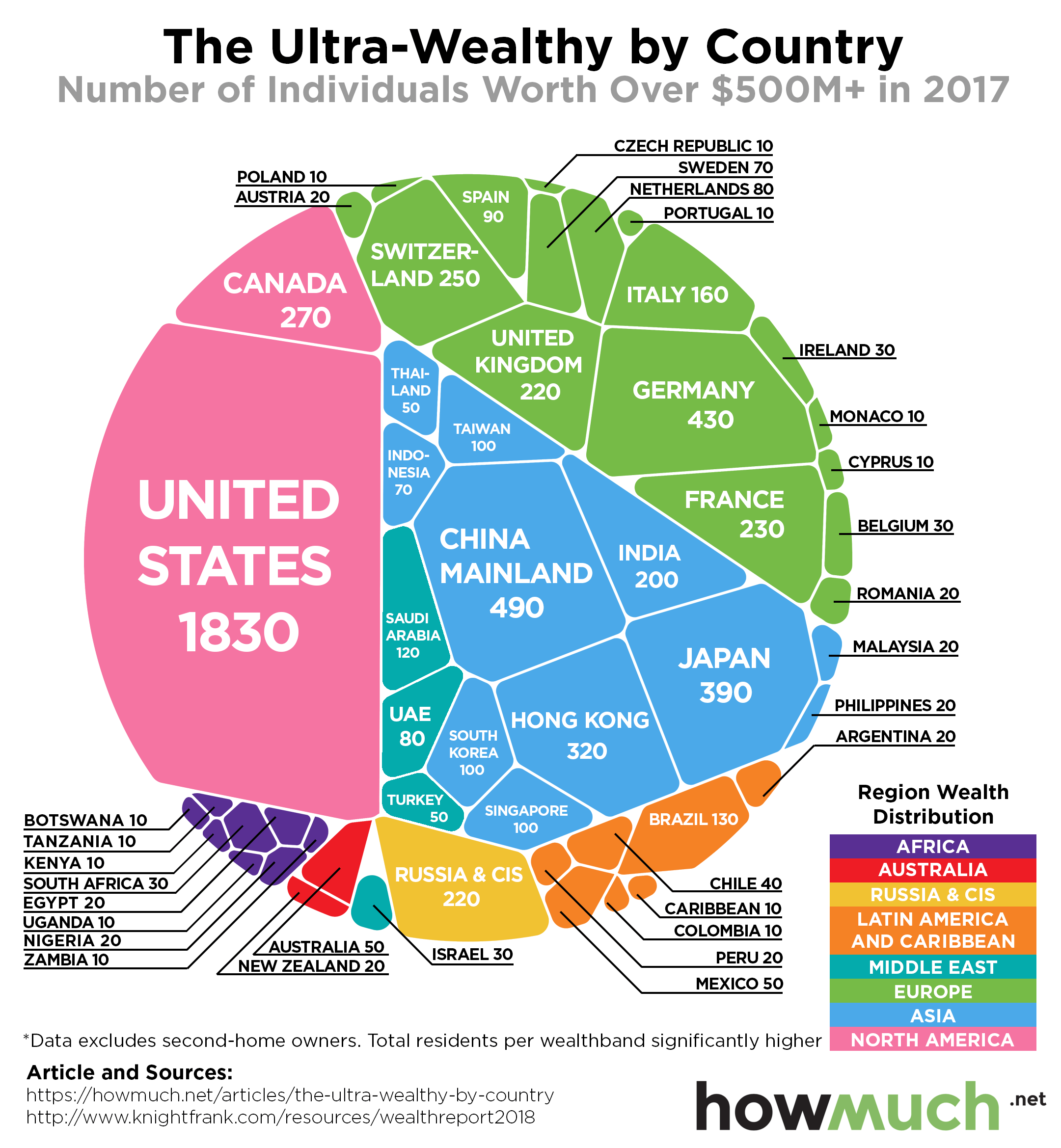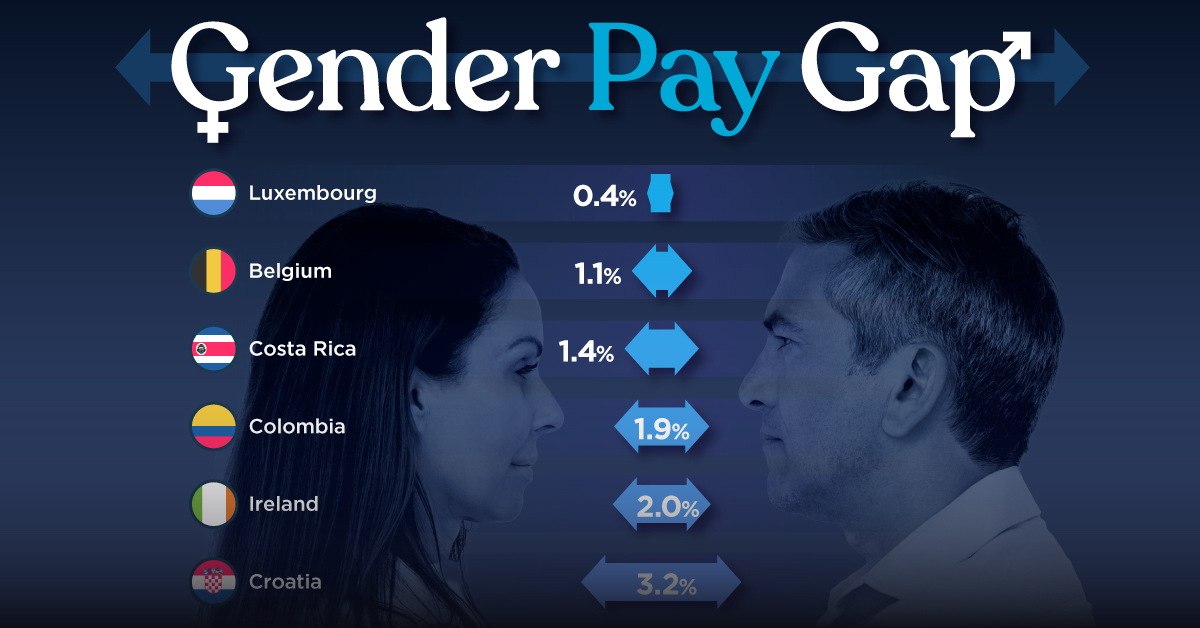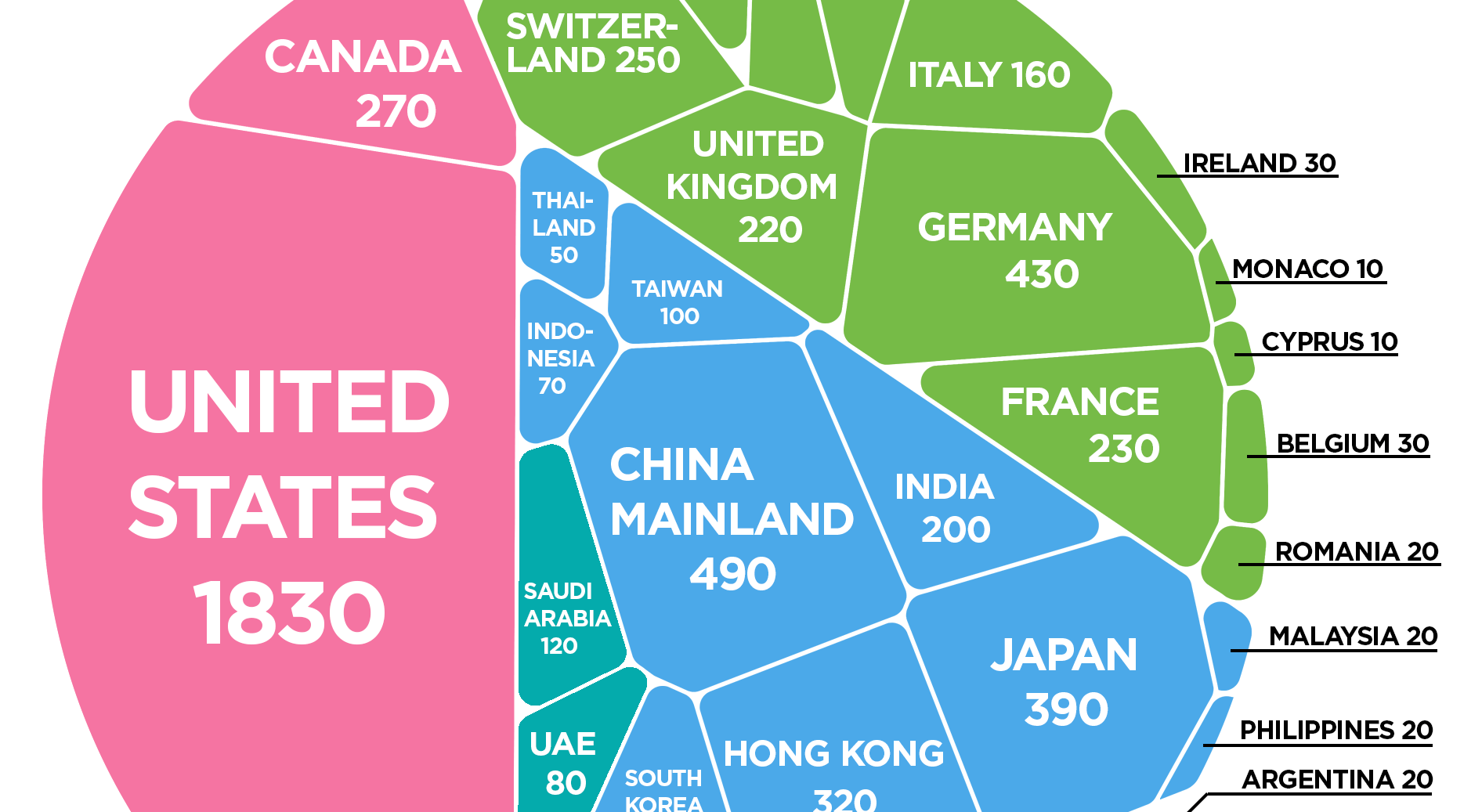Money
Where the World’s Ultra Rich Population Lives

Where the World’s Ultra Rich Population Lives
We’ve recently broken down data on the global population of millionaires by city, and even the residences of the world’s top 50 billionaires.
But still, there’s something extremely interesting about dissecting the lifestyles of the ultra rich – particularly in looking at where they live, and also how they tend to migrate when local conditions are not conducive to wealth-building or the safety of their fortunes and families.
Ultra Rich: By Region
Today’s infographic comes to us from HowMuch.net, and it breaks down the population of ultra high net worth individuals that have personal wealth levels exceeding the $500 million mark. It uses information from the 2018 edition of the Knight Frank Wealth Report.
First, we’ll look at these totals on a regional level:
| Region | Population (>$500M wealth) | % of Global Pop |
|---|---|---|
| North America | 2,100 | 31.8% |
| Asia | 1,860 | 28.1% |
| Europe | 1,680 | 25.4% |
| Middle East | 280 | 4.2% |
| Latin America & Caribbean | 280 | 4.2% |
| Russia & CIS | 220 | 3.3% |
| Africa | 120 | 1.8% |
| Australasia | 70 | 1.1% |
| 6,610 | 100.0% |
As you can see, the vast amount of half-billionaires are located in North America (31.8%), Asia (28.1%), and Europe (25.4%). That means that fewer than 15% of these ultra rich live in the Middle East, Australasia, Russia & CIS, Latin America, and Africa combined.
Ultra Rich: By Country
Now, we’ll look at the 14 countries that have greater than 100 ultra rich people (>$500 million) as residents:
| Rank | Country | Region | Population (>$500M wealth) |
|---|---|---|---|
| #1 | United States | North America | 1,830 |
| #2 | China (Mainland) | Asia | 490 |
| #3 | Germany | Europe | 430 |
| #4 | Japan | Asia | 390 |
| #5 | Hong Kong | Asia | 320 |
| #6 | Canada | North America | 270 |
| #7 | Switzerland | Europe | 250 |
| #8 | France | Europe | 230 |
| #9 | Russia & CIS | Russia & CIS | 220 |
| #10 | United Kingdom | Europe | 220 |
| #11 | India | Asia | 200 |
| #12 | Italy | Europe | 160 |
| #13 | Brazil | Latin America | 130 |
| #14 | Saudi Arabia | Middle East | 120 |
Note: this list excludes second-home owners.
Sitting at the top of the list is the United States with 1,830 people that hold fortunes larger than $500 million. That’s equal to roughly 28% of the global half-billionaire population.
Following the U.S. is China, which counts 810 people as having a wealth over $500 million. These numbers are broken down into Mainland China and Hong Kong on the graph and table, because they were tallied using different sources.
Canada tallies surprisingly high here – the country only ranks #10 globally based on its number of (billionaires), but ranks #6 in terms of half-billionaires with 270 in total.
Lastly, it should be noted that just missing the cut-off on the above list were Taiwan, South Korea, and Singapore, three Asian countries that tied with 100 half-billionaires each.
Demographics
The Smallest Gender Wage Gaps in OECD Countries
Which OECD countries have the smallest gender wage gaps? We look at the 10 countries with gaps lower than the average.

The Smallest Gender Pay Gaps in OECD Countries
This was originally posted on our Voronoi app. Download the app for free on iOS or Android and discover incredible data-driven charts from a variety of trusted sources.
Among the 38 member countries in the Organization for Economic Cooperation and Development (OECD), several have made significant strides in addressing income inequality between men and women.
In this graphic we’ve ranked the OECD countries with the 10 smallest gender pay gaps, using the latest data from the OECD for 2022.
The gender pay gap is calculated as the difference between median full-time earnings for men and women divided by the median full-time earnings of men.
Which Countries Have the Smallest Gender Pay Gaps?
Luxembourg’s gender pay gap is the lowest among OECD members at only 0.4%—well below the OECD average of 11.6%.
| Rank | Country | Percentage Difference in Men's & Women's Full-time Earnings |
|---|---|---|
| 1 | 🇱🇺 Luxembourg | 0.4% |
| 2 | 🇧🇪 Belgium | 1.1% |
| 3 | 🇨🇷 Costa Rica | 1.4% |
| 4 | 🇨🇴 Colombia | 1.9% |
| 5 | 🇮🇪 Ireland | 2.0% |
| 6 | 🇭🇷 Croatia | 3.2% |
| 7 | 🇮🇹 Italy | 3.3% |
| 8 | 🇳🇴 Norway | 4.5% |
| 9 | 🇩🇰 Denmark | 5.8% |
| 10 | 🇵🇹 Portugal | 6.1% |
| OECD Average | 11.6% |
Notably, eight of the top 10 countries with the smallest gender pay gaps are located in Europe, as labor equality laws designed to target gender differences have begun to pay off.
The two other countries that made the list were Costa Rica (1.4%) and Colombia (1.9%), which came in third and fourth place, respectively.
How Did Luxembourg (Nearly) Eliminate its Gender Wage Gap?
Luxembourg’s virtually-non-existent gender wage gap in 2020 can be traced back to its diligent efforts to prioritize equal pay. Since 2016, firms that have not complied with the Labor Code’s equal pay laws have been subjected to penalizing fines ranging from €251 to €25,000.
Higher female education rates also contribute to the diminishing pay gap, with Luxembourg tied for first in the educational attainment rankings of the World Economic Forum’s Global Gender Gap Index Report for 2023.
See More Graphics about Demographics and Money
While these 10 countries are well below the OECD’s average gender pay gap of 11.6%, many OECD member countries including the U.S. are significantly above the average. To see the full list of the top 10 OECD countries with the largest gender pay gaps, check out this visualization.
-

 Misc2 weeks ago
Misc2 weeks agoTesla Is Once Again the World’s Best-Selling EV Company
-

 AI1 week ago
AI1 week agoThe Stock Performance of U.S. Chipmakers So Far in 2024
-

 Misc1 week ago
Misc1 week agoAlmost Every EV Stock is Down After Q1 2024
-

 Money2 weeks ago
Money2 weeks agoWhere Does One U.S. Tax Dollar Go?
-

 Green2 weeks ago
Green2 weeks agoRanked: Top Countries by Total Forest Loss Since 2001
-

 Real Estate2 weeks ago
Real Estate2 weeks agoVisualizing America’s Shortage of Affordable Homes
-

 Maps2 weeks ago
Maps2 weeks agoMapped: Average Wages Across Europe
-

 Mining2 weeks ago
Mining2 weeks agoCharted: The Value Gap Between the Gold Price and Gold Miners













